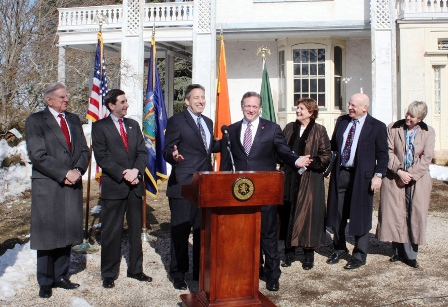
FOR IMMEDIATE RELEASE: February 14, 2012
MEDIA CONTACTS: Collin Nash | (516) 869-7794
Town, County Officials Unveil Historical Marker at Cedarmere Honoring North Hempstead Icon
North Hempstead, NY– North Hempstead Supervisor Jon Kaiman recently joined with Nassau County Executive Edward Mangano, various elected officials, and community leaders to unveil a new historic marker in front of Cedarmere, the historic estate of William Cullen Bryant.
Cedarmere, located on the west side of Bryant Avenue overlooking Hempstead Harbor in Roslyn, was built in 1843 and served as Bryant’s home from 1843 to 1878. It was listed on the National Register of Historic Places in 1986.
“People drive past here every day and not only do they not appreciate the beautiful environment around them, but they overlook this property as well,” said Supervisor Kaiman. “Putting up this marker seems like a small task, but it’s significant. A simple marker can make sure this story is told.”
Also attending the ceremony were North Hempstead Town Clerk Leslie Gross, Nassau County Legislator Wayne Wink, Town of North Hempstead Historian Howard Kroplick, Friends of Cedarmere President John B. Dawson, Jr., Friends of Cedearmere Vice President Lee Shaw, Roslyn Landmark Society Executive Director Franklin Hill Perrell, and Long Island North Shore Heritage Area Executive Director Jennifer Sappell.
The need for a historic marker was first realized by North Hempstead Historian Howard Kroplick. Kroplick believed that placing a marker was a crucial step in preserving both the dynamic history of William Cullen Bryant and eventually the Cedarmere estate.
He worked with Supervisor Kaiman and Town officials to secure a grant through the William G. Pomeroy Foundation Historic Marker Grant Program. The grant ended up paying for the marker in its entirety.
“I commend all of those who have taken the time to preserve this history and pass it on to future generations,” said County Executive Mangano. “There’s nothing like stepping back in history. That’s what this important marker allows us to do – revisit the great history of our Town, our County, and our community.”
William Cullen Bryant is one of North Hempstead’s most famous former residents. A poet, journalist, long-time editor of the New York Evening Post, and civic leader, Bryant stood among the most celebrated figures in nineteenth-century America.
Bryant served as editor and publisher of The New York Evening Post for 50 years. A passionate conservationist and horticulturalist, he used his editorials to rally support for Central Park and the Metropolitan Museum of Art. He defended immigrants and championed the rights of workers to form labor unions. He was also a strong abolitionist who helped Abraham Lincoln win presidential election. Recently, the Roslyn Viaduct was renamed in his honor.
“In days of economic strife and fiscal constraint on all levels of government, one of the greatest risks we face is losing our history,” said County Legislator Wink. “I hope this marker is not just a symbol of William Cullen Bryant and all of the amazing things he did, but a reminder of how crucial it is to protect significant sites like this.”
Right now, Cedarmere is not open to the public. But Friends of Cedarmere, an organization dedicated to restoring and re-opening the mansion, is raising money and collaborating with local government to make that day a reality.
“This beautiful house, and the person that lived here, have such an amazing story that needs to be told,” concluded Supervisor Kaiman. “We’re going to make sure we maintain this important property.”

Friends of Cedarmere President John B. Dawson, Nassau County Legislator Wayne Wink, North Hempstead Supervisor Jon Kaiman, Nassau County Executive Edward Mangano, North Hempstead Town Clerk Leslie Gross, Town of North Hempstead Historian Howard Kroplick, and Long Island North Shore Heritage Area Executive Director Jennifer Sappell were all present at the Cedarmere historical marker ceremony.